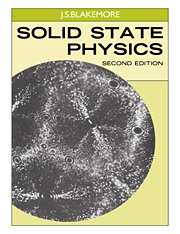Book contents
- Frontmatter
- Contents
- Preface
- General references
- Chapter One CRYSTALLINITY AND THE FORM OF SOLIDS
- Chapter Two LATTICE DYNAMICS
- Chapter Three ELECTRONS IN METALS
- Chapter Four SEMICONDUCTORS
- Chapter Five DIELECTRIC AND MAGNETIC PROPERTIES OF SOLIDS
- TABLE OF SOME USEFUL NUMERICAL CONSTANTS
- AUTHOR INDEX
- SUBJECT INDEX
Chapter One - CRYSTALLINITY AND THE FORM OF SOLIDS
Published online by Cambridge University Press: 05 June 2012
- Frontmatter
- Contents
- Preface
- General references
- Chapter One CRYSTALLINITY AND THE FORM OF SOLIDS
- Chapter Two LATTICE DYNAMICS
- Chapter Three ELECTRONS IN METALS
- Chapter Four SEMICONDUCTORS
- Chapter Five DIELECTRIC AND MAGNETIC PROPERTIES OF SOLIDS
- TABLE OF SOME USEFUL NUMERICAL CONSTANTS
- AUTHOR INDEX
- SUBJECT INDEX
Summary
Solid materials can be classified according to a variety of criteria. Among the more significant of these is the description of a solid as being either crystalline or amorphous. The solid state physics community has tended during the period from the mid-1940's to the late 1960's to concentrate a much larger effort on crystalline solids than on the less tractable amorphous ones.
An amorphous solid exhibits a considerable degree of short range order in its nearest-neighbor bonds, but not the long range order of a periodic atomic lattice; examples include randomly polymerized plastics, carbon blacks, allotropic forms of elements such as selenium and antimony, and glasses. A glass may alternatively be thought of as a supercooled liquid in which the viscosity is too large to permit atomic rearrangement towards a more ordered form. Since the degree of ordering of an amorphous solid depends so much on the conditions of its preparation, it is perhaps not inappropriate to suggest that the preparation and study of amorphous solids has owed rather less to science and rather more to art than the study of crystalline materials. Intense study since the 1960s on glassy solids such as amorphous silicon (of interest for its electronic properties) is likely to create a more nearly quantitative basis for interpreting both electronic and structural features of noncrystalline materials.
In the basic theory of the solid state, it is a common practice to start with models of single crystals of complete perfection and infinite size.
- Type
- Chapter
- Information
- Solid State Physics , pp. 1 - 86Publisher: Cambridge University PressPrint publication year: 1985



